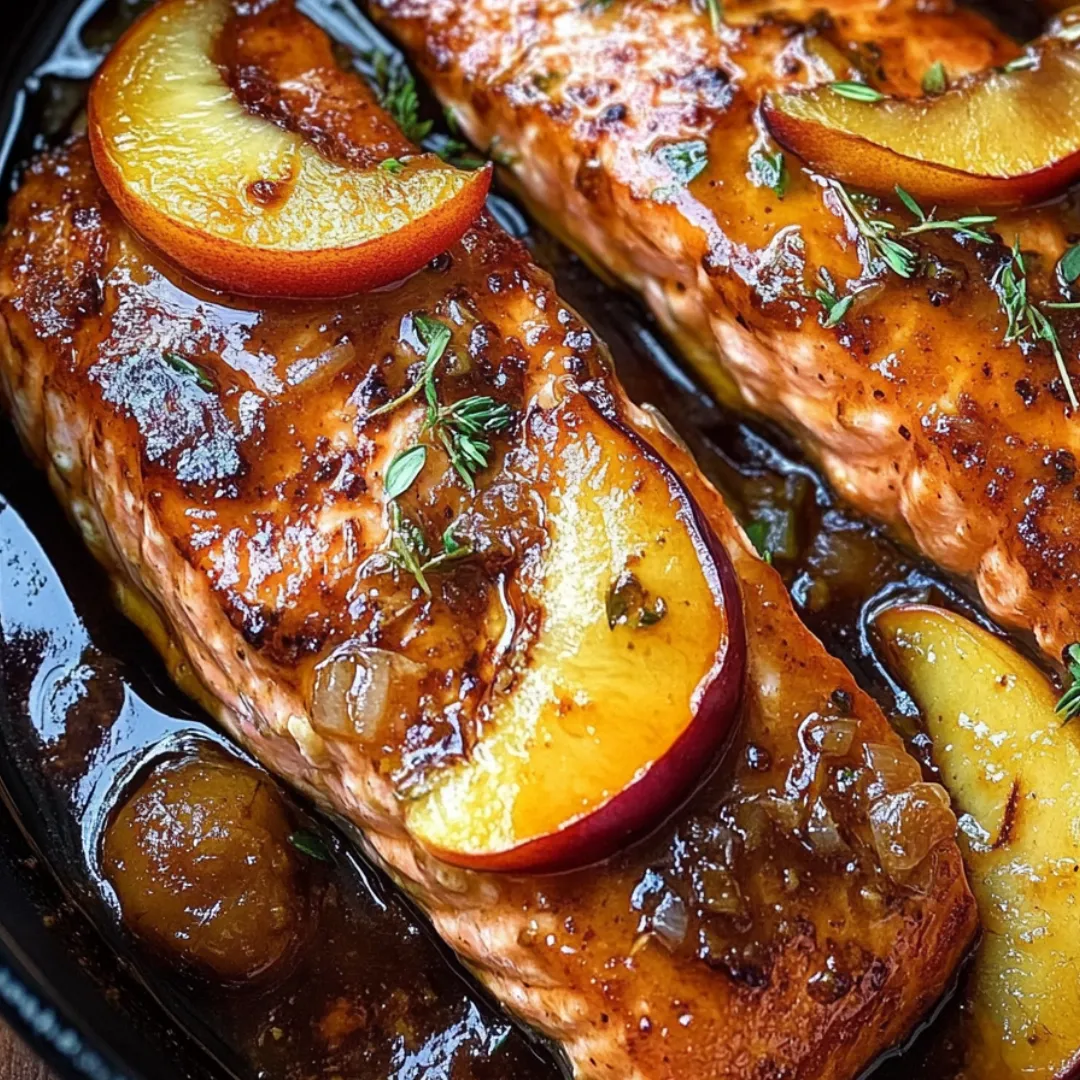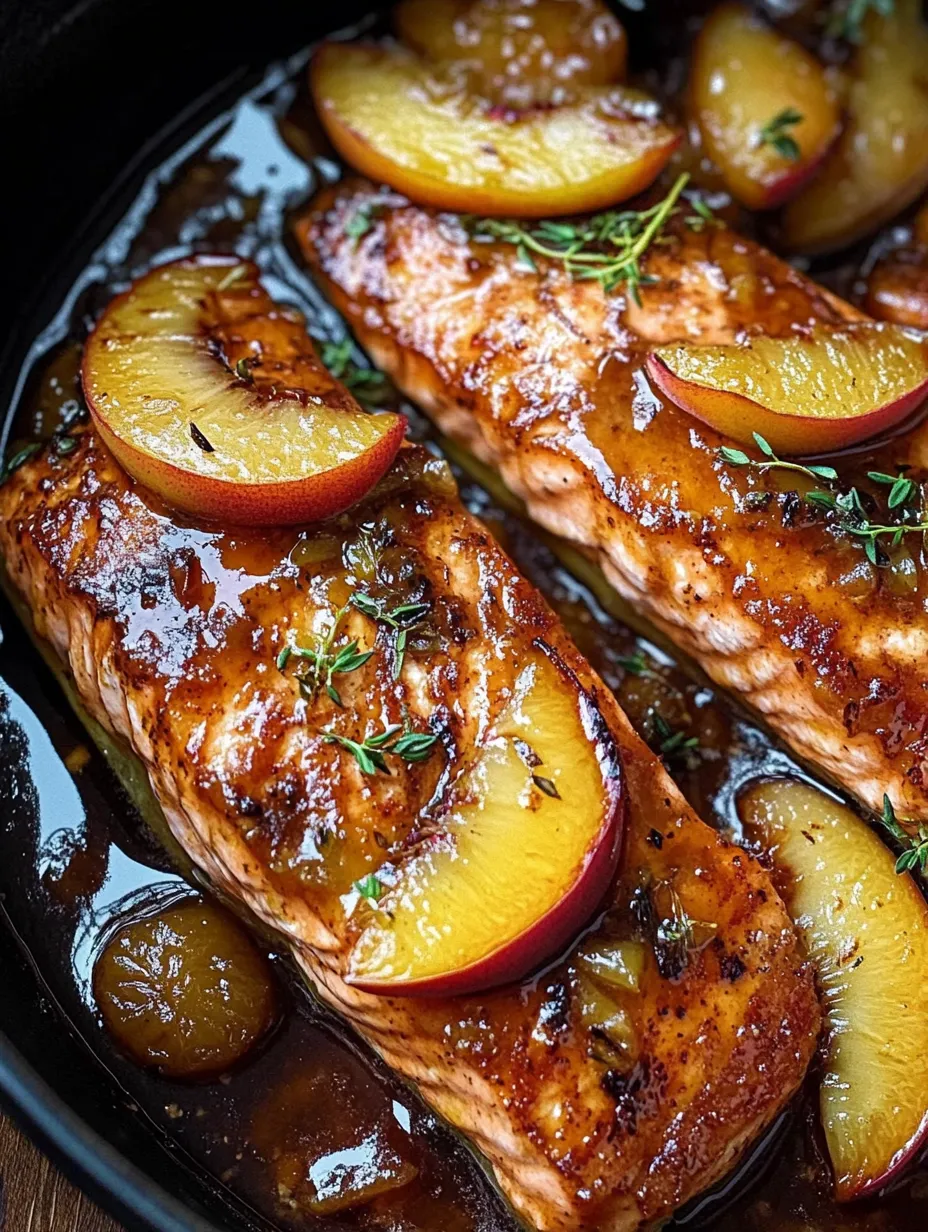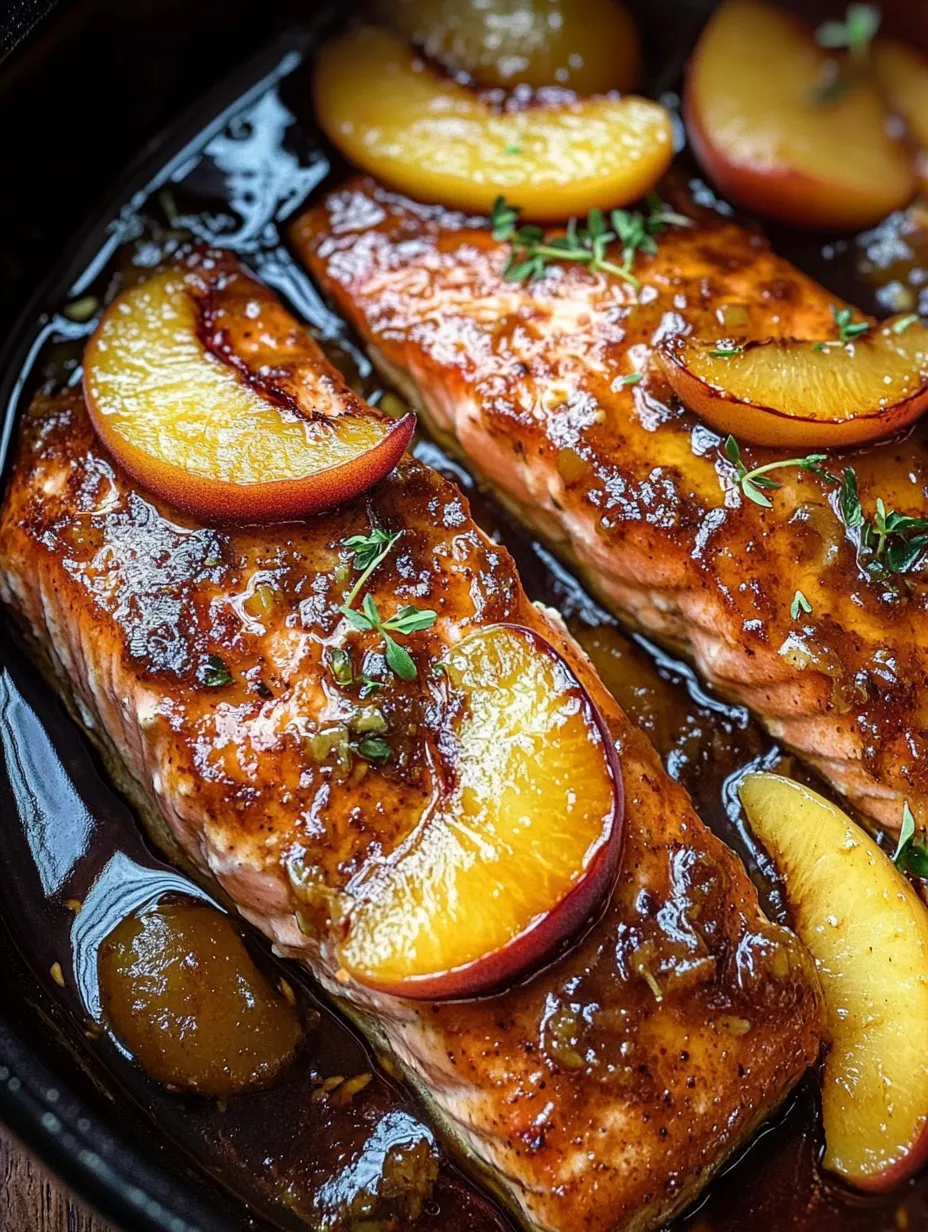 Pin it
Pin it
Bourbon Peach Roasted Salmon transforms ordinary salmon fillets into an extraordinary culinary experience by marrying the rich flavors of bourbon with the natural sweetness of peaches. This elegant dish features salmon fillets marinated in a luscious bourbon-peach mixture, seared to perfection, and then roasted with fresh peach slices until the sauce caramelizes into a sticky, flavorful glaze. The combination creates a perfect harmony of sweet, savory, and subtly spiced notes that complement the natural richness of the salmon. Whether for a weeknight dinner or special occasion, this dish delivers impressive results with minimal effort and ingredients.
The first time I made this bourbon peach salmon was for a summer dinner party where I wanted something special but not fussy. When I brought the sizzling skillet to the table, the caramelized aroma of peaches and bourbon created an instant moment of anticipation. After the first bite, my typically reserved brother-in-law actually closed his eyes and said, "This is what summer should taste like." Even the children at the table, who ordinarily approach salmon with suspicion, eagerly devoured their portions, proving that the sweet peach elements make this dish universally appealing. Since then, it's become my signature dish for celebrations throughout peach season, with friends requesting it specifically when they visit.
Essential Ingredients
- Salmon fillets: Choose center-cut pieces with the skin on for even cooking and maximum flavor. Look for firm, bright-colored flesh with no brown spots and a fresh, oceanic smell. Wild-caught salmon generally offers superior flavor and nutritional benefits compared to farmed varieties.
- Peach preserves: Forms the sweet base of the marinade, providing concentrated peach flavor and natural sweetness. Select quality preserves with visible peach pieces for the best texture and flavor in the finished glaze.
- Bourbon: Adds depth, warmth, and subtle oak notes that complement both the salmon and peaches. The alcohol cooks off, leaving behind complex caramel and vanilla flavors. Choose a mid-range bourbon that you'd enjoy sipping for the best flavor profile.
- Fresh peaches: Use ripe but firm peaches that hold their shape when cooked. The fresh slices soften and release their juices during roasting, creating pockets of intense, fresh peach flavor throughout the dish. Look for fragrant peaches that yield slightly to gentle pressure.
- Soy sauce: Provides essential umami depth and balances the sweetness with savory notes. The salt content also helps season the salmon throughout. Low-sodium varieties work well if you're monitoring salt intake.
- Dijon mustard: Adds tangy complexity and helps emulsify the marinade while providing subtle heat that enhances the other flavors. Coarse-ground varieties offer more texture and visual appeal in the finished sauce.
- Garlic: Provides aromatic foundation and savory depth to the marinade. Fresh minced garlic delivers significantly more flavor than pre-packaged alternatives.
- Apple cider vinegar: Introduces necessary acidity that balances the sweet and rich elements while tenderizing the salmon. The mild fruity notes complement the peach flavor.
- Red pepper flakes: Adds a gentle heat that cuts through the richness and sweetness, creating a more balanced flavor profile. Adjust the amount based on your heat preference.
 Pin it
Pin it
Step-By-Step Preparation
- Step 1:
- Create the bourbon-peach marinade with care - In a medium mixing bowl, combine ¾ cup peach preserves, ¼ cup bourbon, 2 tablespoons olive oil, 2 teaspoons soy sauce, 2 teaspoons apple cider vinegar, 2 teaspoons Dijon mustard, 2 teaspoons minced garlic, 1½ teaspoons kosher salt, ½ teaspoon black pepper, and ¼ teaspoon red pepper flakes. Whisk thoroughly until all ingredients are fully incorporated into a smooth, consistent mixture. The marinade should have a slightly thick consistency that will adhere well to the salmon. Divide the marinade in half, setting aside approximately ¾ cup in a separate container and refrigerating it for later use as the finishing glaze.
- Step 2:
- Marinate the salmon properly - Place four skin-on salmon fillets (each about 6 ounces) in a large resealable plastic bag. Pour the remaining half of the marinade over the salmon, seal the bag while removing as much air as possible, and gently massage the bag to ensure each fillet is thoroughly coated. Refrigerate for at least 30 minutes but no more than 1 hour. The acid in the marinade will begin to cook the proteins if left too long, affecting the final texture of the fish. Turn the bag occasionally during marination to ensure even flavor distribution.
- Step 3:
- Prepare for cooking with precision - When the marination time is complete, preheat your oven to 375°F (190°C). While the oven is heating, remove the salmon from the refrigerator and allow it to sit at room temperature for about 10 minutes. This takes the chill off the fish and promotes more even cooking. Meanwhile, pit and thinly slice two medium, ripe peaches into approximately ¼-inch slices. The uniform thickness ensures the peaches will cook evenly alongside the salmon.
- Step 4:
- Sear the salmon skillfully - Heat a 12-inch oven-safe skillet (preferably cast iron) over medium-high heat. Add 1 tablespoon of olive oil and allow it to heat until it shimmers but doesn't smoke. Remove the salmon fillets from the marinade, gently shaking off any excess, and carefully place them in the hot skillet, skin side up. Discard the used marinade. Allow the salmon to sear undisturbed for 2-3 minutes until a golden-brown crust forms on the bottom. This initial sear creates a flavorful caramelized exterior and helps lock in moisture.
- Step 5:
- Add the peaches with timing in mind - Using a fish spatula or tongs, carefully flip each salmon fillet so the skin side is now in contact with the pan. Immediately arrange the sliced peaches around and between the salmon fillets in the skillet. Cook for an additional 2-3 minutes, allowing the peaches to begin softening and the salmon skin to crisp slightly. The peaches will release some of their juices, creating a flavorful liquid in the pan that will combine with the reserved marinade.
- Step 6:
- Apply the glaze for maximum flavor - Remove the skillet from the heat. Retrieve the reserved marinade from the refrigerator and pour it evenly over the salmon fillets and peaches, ensuring each piece gets a generous coating. The cold marinade will slightly cool the hot pan, preventing any burning as you transfer it to the oven. The reserved marinade is safe to use as it hasn't been in contact with the raw fish.
- Step 7:
- Finish with gentle heat - Transfer the skillet to the preheated oven and roast for 12-15 minutes. Begin checking for doneness at the 12-minute mark by inserting an instant-read thermometer into the thickest part of a fillet. The salmon is perfectly cooked when it reaches an internal temperature of 145°F (63°C) and flakes easily with a fork. The marinade will have thickened into a glossy glaze, and the peaches should be soft but still holding their shape. If the glaze starts to darken too quickly, loosely cover the skillet with foil to prevent burning.
- Step 8:
- Rest briefly before serving - Remove the skillet from the oven and allow the salmon to rest for 2-3 minutes before serving. This brief resting period allows the juices to redistribute throughout the fish, ensuring maximum moisture and flavor. Garnish with fresh chopped parsley for a bright color contrast and fresh herbal note that complements the sweet-savory glaze. Serve directly from the skillet for a rustic presentation, or carefully transfer to a serving platter, spooning the peaches and glaze over and around the salmon.
The Art of Salmon Selection
The foundation of this exceptional dish begins with choosing the right salmon. While any salmon variety works well with these flavors, each type brings distinctive characteristics to the final dish.
King (Chinook) salmon, with its high fat content and rich flavor, creates the most luxurious version of this dish. The robust texture stands up beautifully to the bold flavors in the marinade while remaining buttery and tender.
Sockeye salmon, identifiable by its vibrant red color, offers a stronger, more distinctive salmon flavor that creates an interesting counterpoint to the sweet peach elements. Its firm texture holds up well to the searing process.
Coho (Silver) salmon provides a more delicate flavor profile with moderate fat content, allowing the bourbon and peach flavors to take center stage while still contributing its own subtle character.
Farm-raised Atlantic salmon, the most widely available variety, works perfectly well in this recipe. Its milder flavor and consistent quality make it a reliable choice, particularly if wild-caught options aren't available.
Regardless of variety, look for salmon with moist, firm flesh that springs back when gently pressed. The skin should be intact and shiny, and the flesh should have a fresh, clean scent without any strong fishiness.
I've made this dish countless times and discovered that the quality of each ingredient truly matters. My first attempt used bottled bourbon barbecue sauce with peach added, and while acceptable, it lacked the bright, fresh flavors that make this version special. Similarly, I once substituted canned peaches when fresh weren't available, but they disintegrated during cooking. Now I know that if fresh peaches aren't in season, it's better to just use the preserves in the marinade and skip the sliced peaches altogether. The most dramatic improvement came when I started using higher-quality bourbon—nothing expensive, just a step up from the bottom shelf. The depth of flavor it added to the glaze was remarkable, proving that when a recipe has few ingredients, their quality becomes even more important.
 Pin it
Pin it
Serving Suggestions
This bourbon peach salmon pairs beautifully with sides that complement its sweet-savory profile while creating a balanced plate. For a complete summer meal, serve alongside a wild rice pilaf with toasted pecans, which provides nutty, earthy notes that ground the sweeter elements of the salmon.
For a lighter option, a simple arugula salad dressed with lemon vinaigrette offers peppery freshness and acidity that cuts through the richness of the glazed salmon. The bright flavors cleanse the palate between bites, enhancing the overall dining experience.
Grilled asparagus or broccolini makes an excellent vegetable pairing, as the slight char from grilling echoes the caramelized notes in the salmon glaze while adding a different textural element to the meal.
For a more substantial presentation, serve the salmon over creamy stone-ground grits or polenta, allowing the peach bourbon sauce to mingle with the creamy base, creating an indulgent Southern-inspired dish perfect for special occasions.
If serving for a gathering, consider presenting the skillet directly at the table for a rustic, family-style service that showcases the beautiful colors and textures of the dish. The sizzling presentation creates a memorable dining moment.
My final thought on this Bourbon Peach Roasted Salmon is that it perfectly embodies how simple cooking techniques and quality ingredients can create something truly special. There's something magical about how the bourbon cuts through the richness of the salmon while the peaches provide sweet counterpoints in every bite. This dish has become my go-to recipe whenever I want to impress without spending hours in the kitchen. It's elegant enough for special occasions yet simple enough for a weeknight when you want something a little special. The way the glaze caramelizes, creating sticky, flavorful morsels that cling to each bite of salmon, elevates this dish from everyday to extraordinary with minimal effort—the hallmark of truly great home cooking.
Frequently Asked Questions
- → Can I use frozen peaches instead of fresh?
- Yes, though fresh peaches provide the best texture and flavor. If using frozen, thaw and pat dry before adding to the skillet to prevent excess moisture.
- → What kind of bourbon works best for this recipe?
- Any decent quality bourbon will work well. No need to use top-shelf, but avoid the cheapest options as the flavor will come through in the glaze.
- → Can I make this without alcohol?
- Yes, substitute the bourbon with apple juice or peach nectar mixed with 1 teaspoon of vanilla extract for a similar depth of flavor.
- → What sides pair well with this salmon?
- Try serving with wild rice, roasted asparagus, grilled corn, or a simple green salad. The sweet-savory flavors also pair nicely with quinoa or couscous.
- → Can I prepare the marinade ahead of time?
- Absolutely! The marinade can be made up to 2 days ahead and stored in the refrigerator. Just give it a good stir before using it with the salmon.
